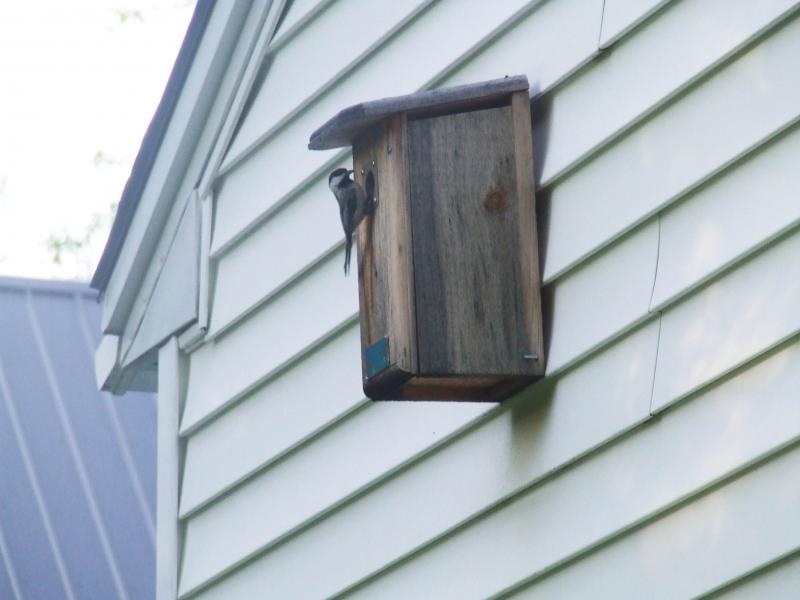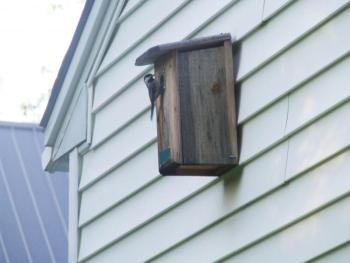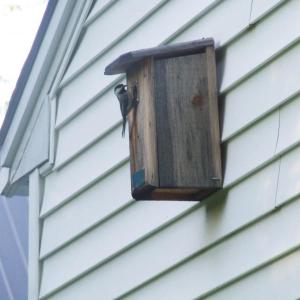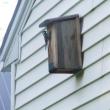We’re Signed up for the new Maine Breeding Bird Atlas - Are You?
A few days ago, we glanced out the window just in time to see a song sparrow flying into one of the shrubs near the house with its beak full of leaves. It was building a nest there, as a song sparrow has done for years. While it is always pleasing to see a bird engaged in the activities of nesting and rearing of young—and fun to be able to track the activities and outcome when it’s near the house—this year such a sighting is particularly exciting. That’s because our observation will become part of the new Maine Breeding Bird Atlas project.
A breeding bird atlas is a project that attempts to map the distribution of all the breeding bird species of an area. The area of interest is overlaid with a grid (imagine laying a volleyball net over a map) and volunteers seek out evidence of breeding in each of the squares of the grid. The types of breeding evidence reported by the volunteers must follow a fairly strict protocol. For example, a singing male that is present in the breeding period on one occasion would be recorded as a “Possible” breeder. A singing male present more than a week, two birds mating, and birds engaged in territorial fights are all examples of types of observations that would be considered “Probable” breeding. The highest level, showing unequivocal evidence of breeding (the “Confirmed” category), includes observations of a bird carrying nesting material, nest with eggs or young, an adult carrying food, a bird sitting on a nest, and other types of evidence.
Breeding bird atlas projects are typically carried out over a number of years (often five). Here in the U.S. and Canada, atlas projects usually cover an entire state or province. Ideally an atlas project will have hundreds, sometimes thousands of volunteer participants and achieve a good spatial coverage. Ensuring that atlas blocks are surveyed from across the area of interest is critical; otherwise you can never be sure that if a species does not show up on the map it is because of a lack of observers in that region or if it really does not occur there.
The first large-scale breeding bird atlas was conceived of and completed in Great Britain back in the late 1960s and early 1970s. Since that time, lots of atlases have been completed across the world. Here in the U.S., Vermont carried out the first state-level breeding bird atlas, publishing a book showing the results in 1985. Believe it or not, Maine was on the leading edge of breeding bird atlases with our state atlas, published in 1987, showing the results of field work carried out from 1978 to 1983. Back then, more than 200 volunteers participated in the atlas project, documenting 201 breeding birds in the state.
The new Maine Breeding Bird Atlas project will collect data from 2018-2022 and hopefully will engage even more volunteers. It will be exciting to see what changes we will see in bird distributions in the nearly 40 years that have elapsed since the last atlas was completed.
Being an atlas volunteer is also super fun! It’s really enjoyable to take on the challenge of looking very closely at the birds in one particular atlas block, and to try to see if there is some patch of a particular type of habitat in that block that may harbor a species that is only found in that habitat.
To sign up for the project and start atlasing, go to: http://www.maine.gov/ifw/fish-wildlife/maine-bird-atlas/index.html.
Jeffrey V. Wells, Ph.D., is a Fellow of the Cornell Lab of Ornithology. Dr. Wells is one of the nation's leading bird experts and conservation biologists and author of “Birder’s Conservation Handbook”. His grandfather, the late John Chase, was a columnist for the Boothbay Register for many years. Allison Childs Wells, formerly of the Cornell Lab of Ornithology, is a senior director at the Natural Resources Council of Maine, a nonprofit membership organization working statewide to protect the nature of Maine. Both are widely published natural history writers and are the authors of the book, “Maine’s Favorite Birds” and the newly published “Birds of Aruba, Bonaire, and Curaçao” from Cornell Press.
Event Date
Address
United States
























